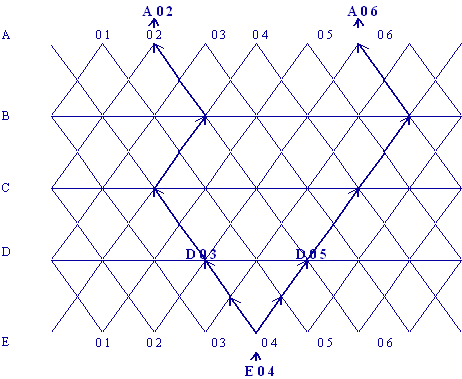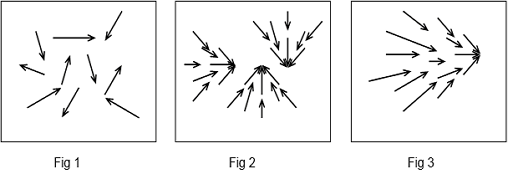
GOAL
ORIENTATION FOR PERSONAL EFFECTIVENESS
Prem Kamble
|
Need to align Goals of Company, Dept & Indiv Make the Goal Known to Everyone |
IDENTIFYING THE STRATEGIC AREAS
DRAW OUT TARGETS AND MILESTONES
 All of us want to perform at work. We want to be more
effective and achieve results. Nothing can be more encouraging and
motivating than the fruits of our good performance.
All of us want to perform at work. We want to be more
effective and achieve results. Nothing can be more encouraging and
motivating than the fruits of our good performance.
What does it take to perform? Are there any quick tips to be more effective?
I will attempt to list some simple ways to improve personal as well as group effectiveness.
Being effective would mean producing more results with the same efforts. Our efforts can yield maximum results only if every effort contributes to the desired result and no effort is counter-productive - that is, we hit the bull's eye every time. Our problem, most often, is that we do not even see the bull's eye and hit our shots hoping that they will hit the bull's eye. When we set out to accomplish our results, are we really clear what it is that we want to achieve? Are we clear what we are up to, and what is our goal or objective?
Defining and being very clear of the objectives, I feel, is the most important step towards effectiveness. The following are some key steps to being Goal Oriented, which we shall subsequently discuss in details. ('Goals' and 'Objectives' are used interchangeably in this article.)
A.
Define your goal clearly
B.
Make it known to everyone in your company, department or team
C. Remind every one of the
Goals from time to time.
It is important to be clear about our goals and objectives. The owner of a Business Group needs to define his Business Group objectives. The head of a company needs to spell out the company's objective and a department head needs to be clear of his department objectives. Each one of us needs to define the objective for every task on hand - however small it may be.
For example if you are convening a meeting with your colleagues, you need to be clear what is the objective, what you would like to achieve at the end of the meeting. As the head of the Information Technology function, when I take up the computerisation of a new area, I must first define its business objectives. I must ask myself "What is the system expected to achieve or deliver for the business?"
It is important that businesses define their company's objectives first so that others in the company can define their goals which are aligned to the company's goals. Some companies may define the goal as 'Producing Quality Products', others as 'Service to the Community' or as 'Maximising Profits'. It is important that the objective is short and specific. It is best if the objective can be expressed in one small sentence. Defining the objective is like deciding where exactly one wants to go, or like having a fixed destination. And having a clear objective is like having one single destination - all your roads must lead to that goal.
Only when we are clear about our destination, we can put all our effort to find out ways to reach there. Unless we are clear where we want to go, we cannot decide which will be the best route to reach there. The road that lies in front of us could be irresistible in several ways - it could be a wide road with smooth finish and gorgeous surroundings. But it cannot be the right one if it does not lead us to our destination. If we are not clear of our destination, we might choose this road based on other factors that are not exactly relevant. We might take our decisions based on the wrong premises.
Defining our objectives clearly can facilitate our decision making at every step. I shall explain this with the help of an illustrative diagram and an example. The following diagram shows how clarity of objectives influences a decision and, most important of all, ensures consistency of decisions.

Imagine that we are at E04 and our destination or objective is A02. The crosses or forks that intersect our path from E to A represent the options or alternatives between which we have to choose. Although the diagram shows only two alternatives at each stage, in real life, we have to choose from multiple options at every step. At every moment and at every stage in our work too, we have to decide which path to choose from several alternatives and crossroads before us.
In this illustration, the options available to us are D03 and D05. If we are clear that our destination is A02 and not, say, A06, we will always choose the alternative that moves us closer to our destination. We will choose D03 and not D05. In every subsequent step, our knowledge of the destination will lead us to take the right decision so that we can reach our goal faster.
Without a clear objective, we are likely to make the wrong choice at times and move away from our destination. Some of our decisions may cancel the effect of our earlier positive actions. Though we may finally reach the destination, we would have spent much more time and effort to reach the destination. It is quite possible that we may never reach the destination and may simply go round and round in circles. With a clear objective, we will be consistent in our decisions and always move towards our goal and never away from it.
The following real life situation will make this point fairly clear. I was implementing a computer application for a sugar mill - that of Sugarcane Accounting system. Simply put, the system keeps an account of sugarcane supplied by the farmers, the amount due to them, the amount recoverable as a result of loan installments and subsidies given, and net payable.
 One of the possible objectives of the Cane Accounting
system could be 'Quick and Accurate information availability to the
Company'. An analysis of the business showed that it was more important
for the business to win the farmers' goodwill by giving them prompt
service and information about their accounts. This helped us to set the
objective for the same system as 'Information for Better Service to the
Farmers' instead of 'Information for the Company'. Read the business analysis
of this case in the article titled "Bringing Computers in"
published in 'Times of India'.
One of the possible objectives of the Cane Accounting
system could be 'Quick and Accurate information availability to the
Company'. An analysis of the business showed that it was more important
for the business to win the farmers' goodwill by giving them prompt
service and information about their accounts. This helped us to set the
objective for the same system as 'Information for Better Service to the
Farmers' instead of 'Information for the Company'. Read the business analysis
of this case in the article titled "Bringing Computers in"
published in 'Times of India'.
In this situation, we had to decide whether to print slips containing each farmer's account and distribute it to each farmer. If the system objective was 'Information for the Company', our decision would have been against printing the slips as the cost of printing and the cost of paper and computer time would not justify it. However since the objective was service to the farmers, we could justify the additional expenditure based on its contribution to the objective.
This illustrates that given a situation, the decisions will be different depending on our objectives. A clarity of the objective helps us to take the right decision and consistently move towards our goal.
In one company, the Personnel Department's objective was 'Defining Organisation charts, deciding positions and promotions'. After some soul searching it was changed to 'Employee satisfaction so that he or she gives his best'. They only had to see how all their actions and decisions changed for the better.
Defining the objectives also helps you to delegate effectively. You need to only set goals. Your subordinates can be more independent and need not have to consult you for every decision. Each person can decide what to do - if it contributes to the goal, he or she can, more often than not, independently decide to do it if contributes to the goal.
Need to align the Goals
of
Company, Departments and Individuals
We talked of the need for each department and each project or task to define a goal. With this, instead of forces acting arbitrarily in all directions (Fig 1), they are concentrated (at least within each department) for achieving specific goals (Fig 2). However, as a whole, the forces may still not move anything, since collectively they may cancel each other. When these same forces are realigned to point in one direction (Fig 3), they could move mountains. The department goals should all be aligned to the company's goals.

Hence, the process of defining the goal should ideally start from the top. The company's objectives should be defined first. Thereafter, all the individual department heads should formulate the objectives of their individual departments aligned to the company's objectives in order to contribute to the overall company's goals.
If the efforts of the individual departments are not aligned with, or directed towards the company's objectives, their efforts quite often offset each other instead of being directed and consolidated into one solid force.
The need for aligning the goals of different departments with the company's goal is best illustrated with the help of the following analogy.
Imagine that you are a part of a group of people pushing and pulling along a cart through thick forest - negotiating potholes, thorns and bushes among tall trees trying to reach a particular spot. The destination is hardly visible through tall trees. Someone in the group has to sit on a pedestal above everyone's shoulders and above the trees and bushes to keep an eye on the destination. The rest of you could be busy negotiating your way - sometimes moving some portion of the cart to the left, sometimes to the right, and sometimes even having to retreat back. However, the net result of all this effort is that the cart moves forward towards the goal.
What would be the result without the person who is keeping an eye on the goal and directing? Each one could push and pull his own way and the cart would never reach its target. Even if it does manage to reach the destination it would be by accident and not by design. In any case it would have taken far more time and covered far more distance to reach the destination.
The example sounds funny, does it? But we do exactly this in the office - push and pull the cart in different directions, too deeply engrossed in our day-to-day problems. We are so busy negotiating one problem after another, that we have no time to raise our head above our shoulders to see the destination, or to see where we are heading.
Some companies take pains to explain to each individual what the Company's objectives would mean to him in his job, how it could translate into actions specifically in case of his work. In a company where the company's objectives are not clear, it is like the example above without the director.
Make
the Goal Known to Everyone
As much as defining the company's objective clearly, it is necessary that everyone is aware of it. It is important for everyone to know why the company exists and what for they themselves labour all day.
Only if all your team members know what is the group objective can they contribute to it. Just as all departments need to work towards the company's goal all members of a department need to work towards the common department goal. All the energies of the team should be utilised to give positive result. This is important because, unless we are cautious, some of the teammates may unknowingly nullify the efforts of the others.
Remind the Team
of the Goal from Time to Time
Simply making everyone in the team aware of the objectives is not enough. It is important to remind them of the goals from time to time. This is essential because we often get so busy with the pressure of work and so engrossed in the technical details that we lose sight of the objective in our pursuit of technical perfection. We get lost in the means and forgot the end objective.
 Those conducting group discussions or those leading a
meeting will be familiar with the following situation which illustrates
our point. In heated discussions, one argument often leads to another,
and another to yet another and the original topic of the discussion is
forgotten. Quite often, the discussions drift away from the topic and
the organiser has to be extremely vigilant to bring the group back on
the track to the original topic of discussion.
Those conducting group discussions or those leading a
meeting will be familiar with the following situation which illustrates
our point. In heated discussions, one argument often leads to another,
and another to yet another and the original topic of the discussion is
forgotten. Quite often, the discussions drift away from the topic and
the organiser has to be extremely vigilant to bring the group back on
the track to the original topic of discussion.
Exactly the same is true about our work. We get swept away in details and lose track of the objective. Hence it is important to bring everyone back on the track by reminding them of the objectives from time to time.
For example, for a Materials Manager, the valuation method for items issued and items returned after issue can be a tricky problem. One can spend days on end discussing the valuation method - but if we look at the final objective, is it really important to value it so exactly? What if you adopt an approximate but simpler method? In our pursuit of perfection and precision, we often forget to think whether it is really required to split hair over something when an approximation is more than sufficient.
Differentiate
between Objectives and Means
We normally are lost in the procedures when we need to be rather focusing on the end objective. If we concentrate on the objectives, we will not close our eyes to new options. We can find new ways to achieve our objectives, ways which we would never have thought of if we were too busy with the means.
For example, for an Information Technology department, the end objective may be to provide the information in a cost effective way. Developing systems in-house is one of the means of achieving the goal. Alternately, it is also possible to buy a package or get the software developed by an outside consultant. If the department gets too busy in system design and programming, it can never even think of the other possible options. What are the means one adopts may not be so important so long as my objective is met.
We often make the mistake of making the means the end (or objective) and go round in circles. We get so deeply involved in the method or means that the method becomes sacred to us. What is important is not "what I am doing" but "why I am doing what I am doing". This may not be so obvious and may need some soul searching to realize if you are over-involced in the method and have lost track of the objective.
Generally, the goal will not change over time, but means may change depending on conditions - means will change from place to place and from time to time. Means will also change as technology evolves. So it is important to keep an eye on the objective and not get fixated to the means.
IDENTIFYING THE STRATEGIC
AREAS
We saw that defining our goal was like specifying where exactly we want to go. Once we are clear where we want to go, the next job is to put all our effort to find out best possible ways to get there.
It may not be obvious, but we do make the mistake of looking for success factors without thinking of a clear goal. When we do, we are sure to miss out on such issues that may be critical but not so obvious, issues that may be minor but strategic. Only after clearly defining our Objective, we should identify the strategic areas that will contribute to that objective. Strategic areas are means that will yield faster results with less efforts..
The strategic issues can change from time to time depending on the business conditions, availability of resources, etc. For example, for the Information Technology department, the user friendliness of the software becomes a strategic area for acceptance if the user awareness is very low. On the other hand, when resources are a constraint, utilisation of existing hardware could be critical, and when software skills are scarce, retaining the existing employees by motivating them becomes the strategic factor.
The strategic factors can also differ from place to place. For instance, for the Personnel and Administration department, strategic factors for employees' satisfaction could be different in cities as compared to smaller towns.
DRAW OUT TARGETS AND
MILESTONES
After identifying the strategic areas, it is important to identify specific results we need to produce in these areas, and set up targets to achieve these results. The results should be specific, measurable and time bound, and be related to the strategic areas which are critical for achieving our objective. On the way to achieving the targets, there must be well-defined milestones (or intermediate measurable results) and target dates. This will help to monitor the progress from time to time and take corrective steps if required.
Milestones are short term goals. Long Term goals may not be seen easily by everybody. Short Term goals are achievable immediately. Milestones or short term goals are like guides that ensure that you are on the right track.
We often say that the targets must be realistic. This should not mean that we set targets which can be achieved so easily that they do not drive us to achieve beyond our normal capabilities. I feel, sometimes unrealistic targets can set us thinking and bring out imaginative ways of achieving our targets, ways that we would have never thought of if we had set the targets realistically. As the saying goes, "Some see things as they are and say 'why', some dream of things and say 'why not?'".
When you set a target which seems unachievable to the ordinary mind and say 'why not?', it demands that you bring out your best.
Each result that you desire to achieve in your strategic area is a project by itself and needs to be broken down to subprojects and individual activities. Each activity needs to have a target date for completion.
We need to delegate the subprojects and activities and monitor the progress based on the milestones set. The assignment of responsibility and the targets set must be clear.
The success of any project is written in the first step - whether the goals have been clearly defined.
Related Readings:
Bringing Computers In (Real Case of Goal Orientation)
My Success Stories
More Articles on Team Development
More Articles on Skill Development
All Articles by
Prem Kamble
Also See:
|
Need to align Goals of Company, Dept & Indiv Make the Goal Known to Everyone |
IDENTIFYING THE STRATEGIC AREAS
DRAW OUT TARGETS AND MILESTONES
|
Need to align Goals of Company, Dept & Indiv Make the Goal Known to Everyone |
IDENTIFYING THE STRATEGIC AREAS
DRAW OUT TARGETS AND MILESTONES
|
Need to align Goals of Company, Dept & Indiv Make the Goal Known to Everyone |
IDENTIFYING THE STRATEGIC AREAS
|
Need to align Goals of Company, Dept & Indiv Make the Goal Known to Everyone |
IDENTIFYING THE STRATEGIC AREAS